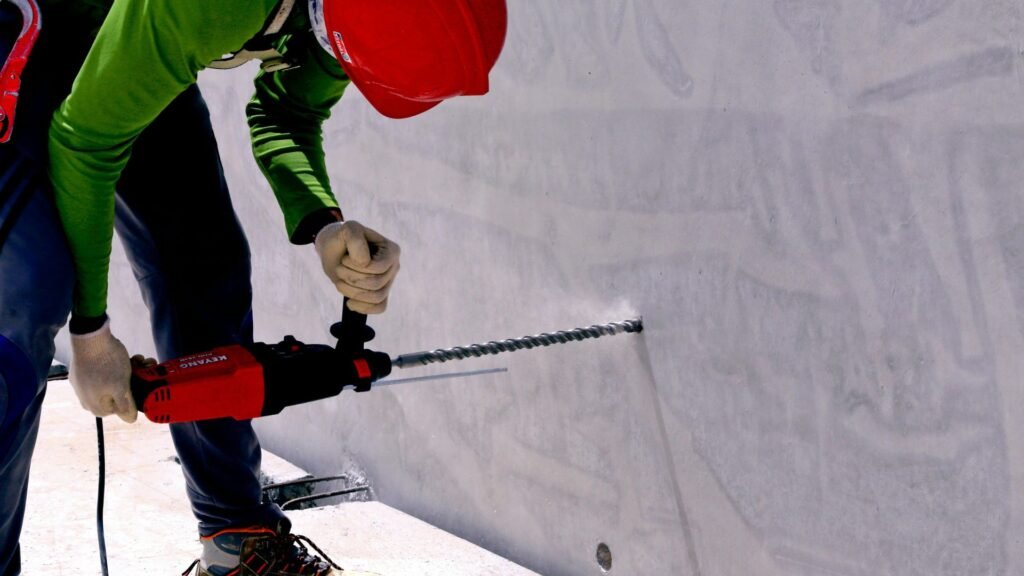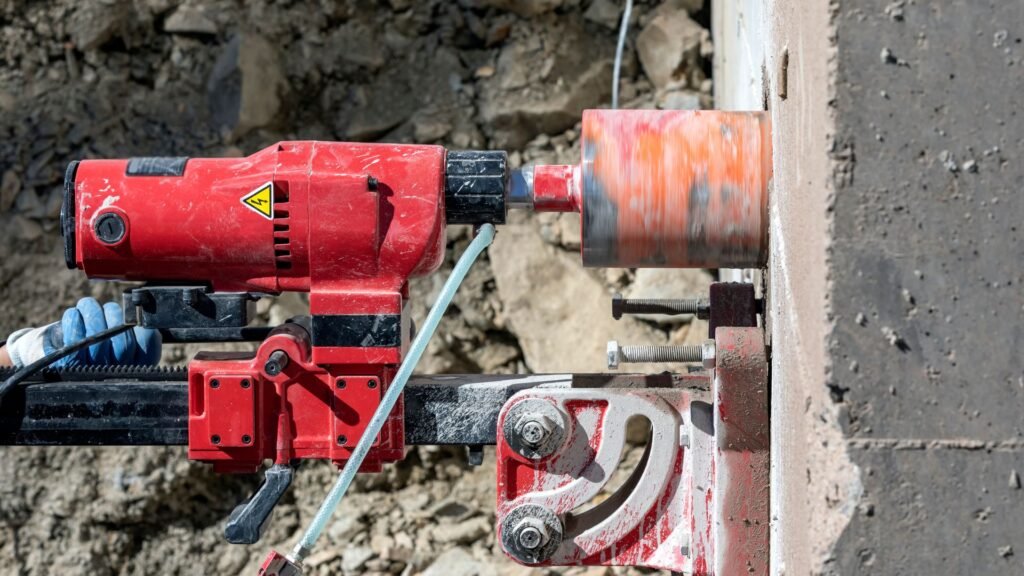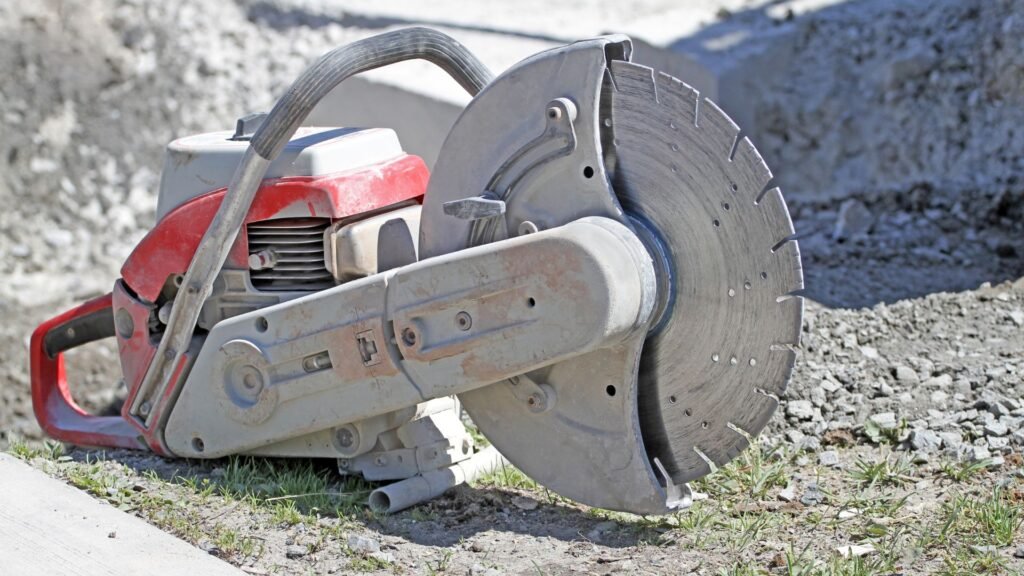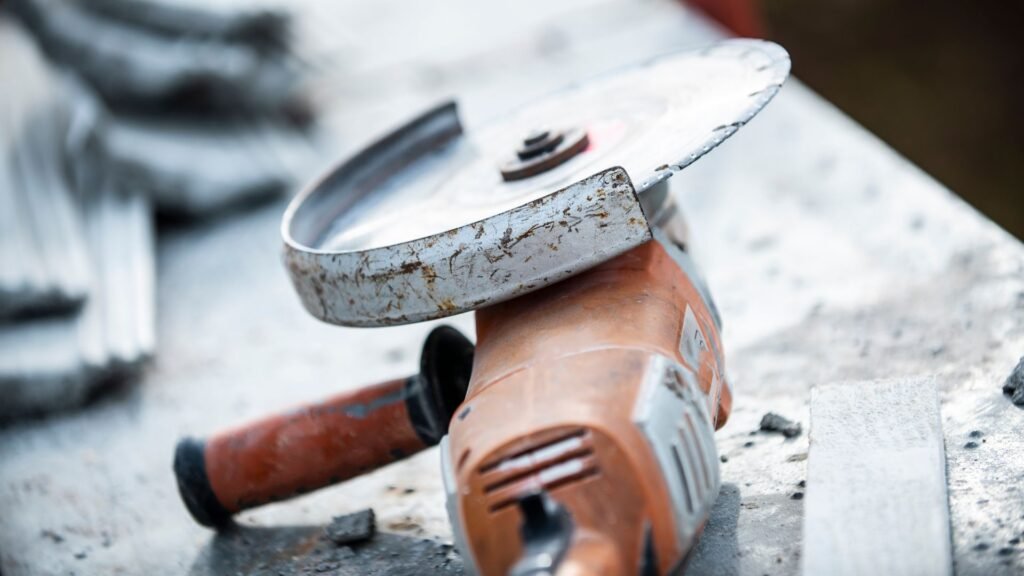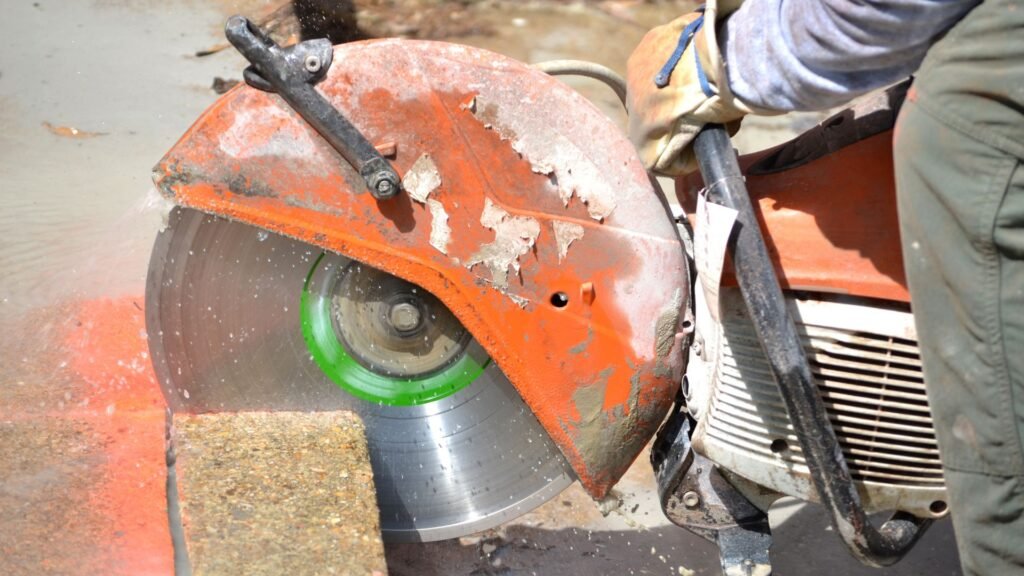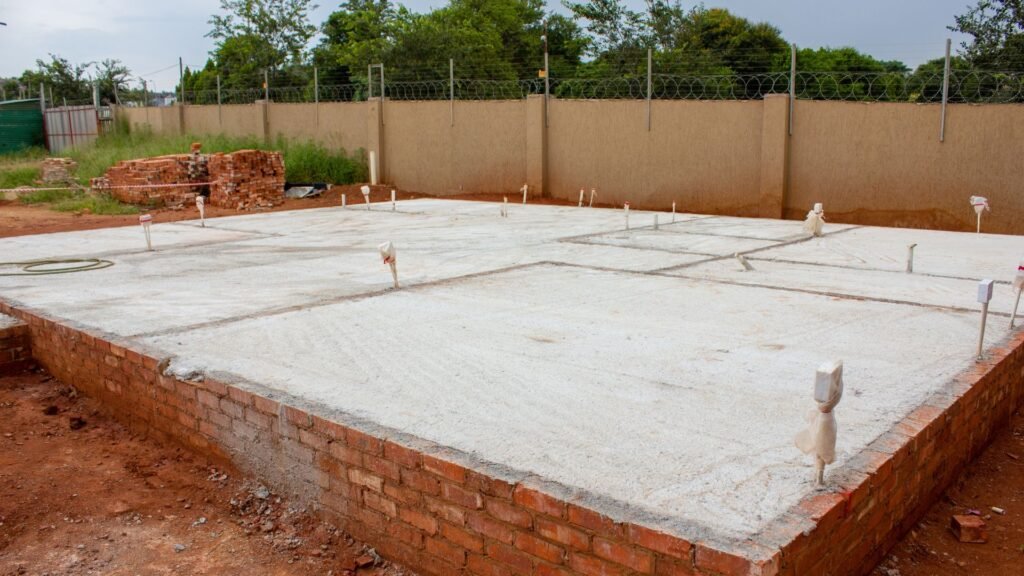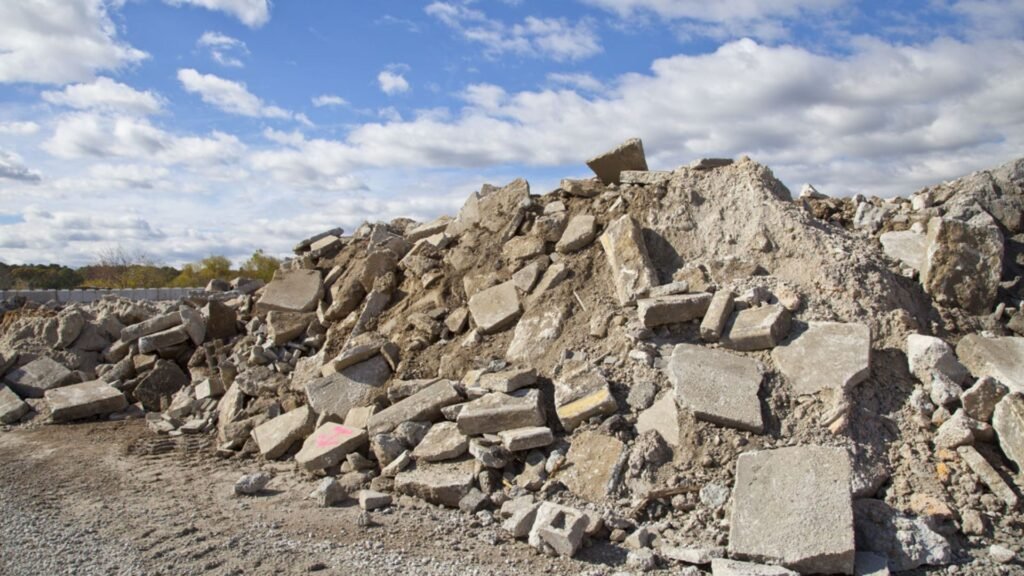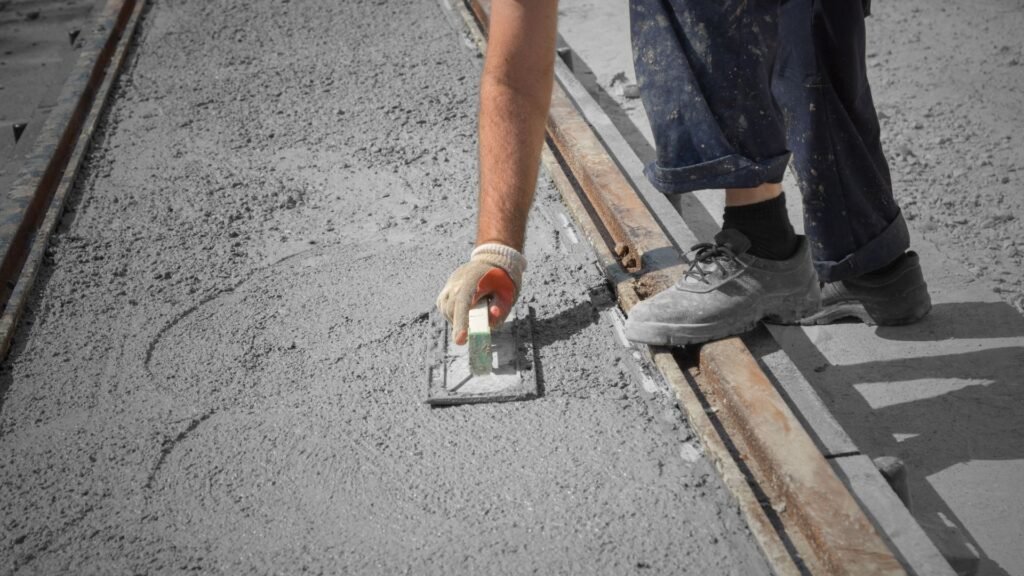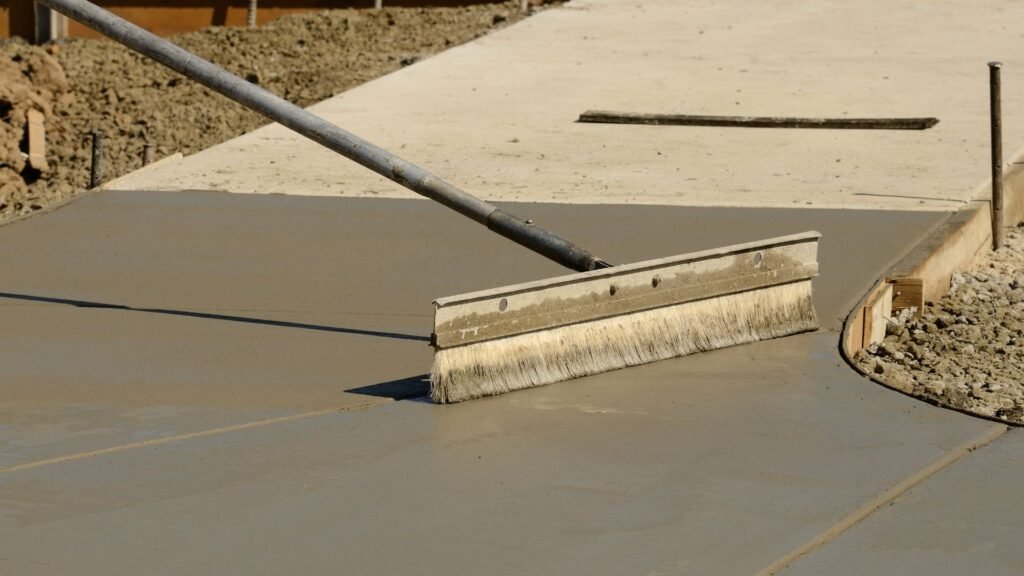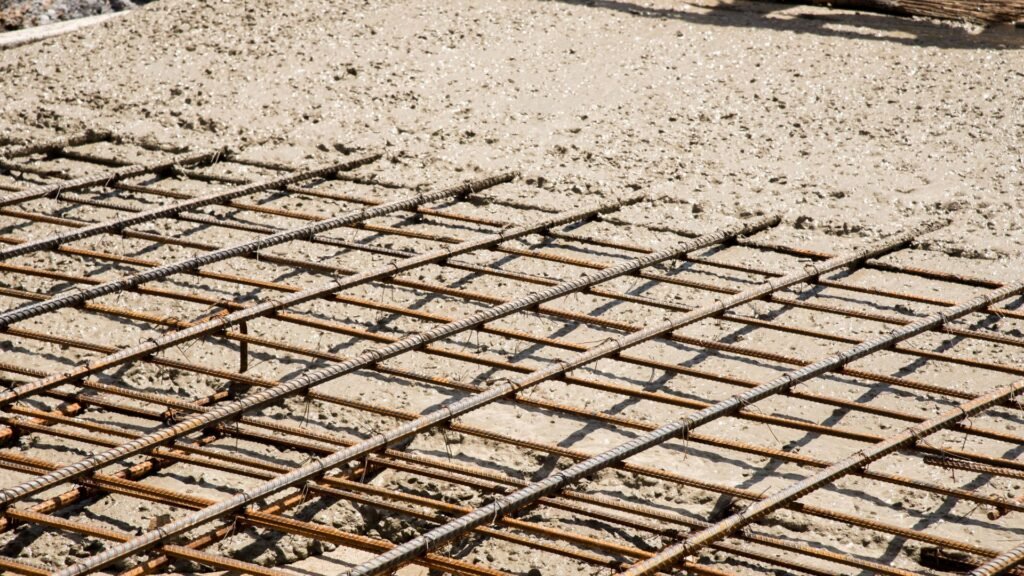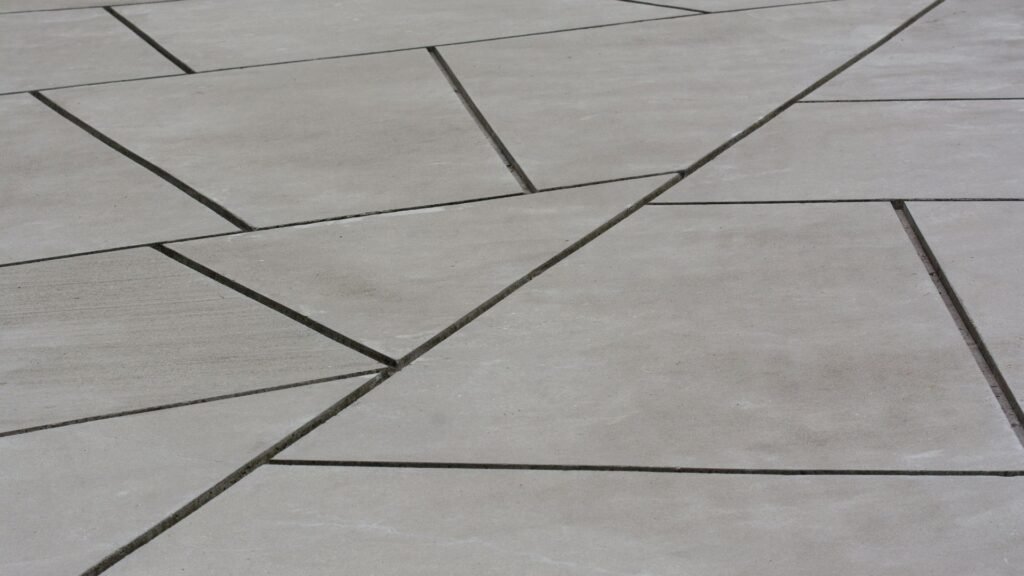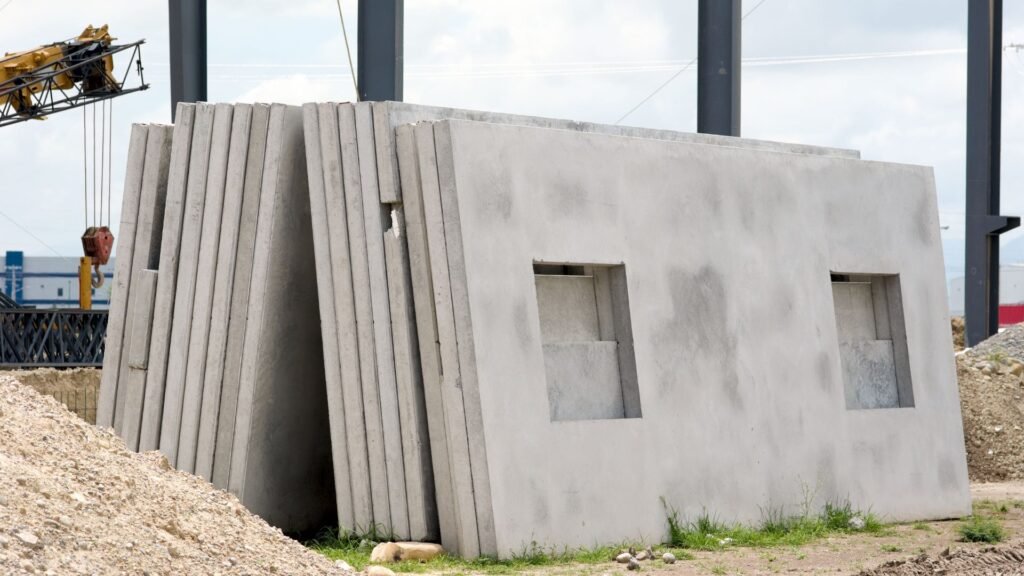Welcome to your go-to guide on drilling holes in concrete, a task that often feels intimidating but is completely doable with the right tools and know-how. Concrete is tough, dense, and far less forgiving than wood or drywall, which is why many people run into broken bits, clouds of dust, or holes that don’t turn out as planned. Whether you’re hanging shelves, mounting a TV, or running cables through a wall, learning the correct approach can save you time, money, and frustration. In this article, we’ll walk through everything you need to know—from choosing the right drill and bits to handling dust and preventing cracks—so you can tackle your next project with confidence and precision.
To drill holes in concrete, use a hammer drill with a carbide-tipped masonry bit. Mark the spot, start with a small pilot hole, and keep the drill perpendicular to the surface. Apply steady pressure without forcing the drill, and pause to clear out dust as you go. For deeper or larger holes, work gradually and finish by cleaning the hole before inserting anchors or screws.
Table of Contents
Understanding Concrete As A Material
Concrete is one of the most widely used building materials because of its durability and strength. While it provides a solid and long-lasting surface, those same qualities make it challenging when you need to drill holes. Unlike wood or drywall, which are relatively easy to penetrate, concrete contains several components that work together to create its hardness. Knowing why concrete is difficult to drill, how it differs from similar materials, and when you might need to drill into it will help you approach the task with more confidence and fewer mistakes.
Why Concrete Is Hard To Drill: Aggregates, Density, And Reinforcement Bars
Concrete is not a single uniform material. It is made up of a mix of cement, water, sand, and coarse aggregates like gravel or crushed stone. These aggregates create a dense structure that provides strength but also increases resistance to drilling. The hardness of the aggregates can cause regular drill bits to wear out quickly or break. In addition to aggregates, many concrete structures contain reinforcement bars, also known as rebar. These steel rods add strength but can bring drilling to a stop if you are not prepared with the right tools. This combination of density and reinforcement is why drilling into concrete requires a hammer drill and specialized masonry bits.
Difference Between Concrete, Cement, And Masonry
Many people confuse concrete with cement, but they are not the same. Cement is a binding agent, usually made of limestone and clay, that hardens when mixed with water. Concrete, on the other hand, is the finished mixture that combines cement, sand, aggregates, and water. Masonry refers to structures built using bricks, stones, or blocks, often held together with mortar. While you may use similar tools for drilling into masonry and concrete, understanding these differences helps you choose the correct technique and drill bits. Concrete’s combination of cement and aggregates makes it tougher to drill compared to standard masonry blocks.
When You Might Need To Drill: Installing Shelves, Anchors, Pipes, Or Cables
Drilling into concrete is a common task for both homeowners and professionals. You may need to create holes for wall anchors when mounting heavy shelves, TV brackets, or storage units. Running electrical conduits or plumbing often requires drilling precise openings in concrete walls or floors. Even something as simple as hanging outdoor fixtures like lights or security cameras may involve drilling. Each of these tasks demands proper preparation to ensure that the hole is clean, accurate, and strong enough to hold the fixture safely.
Concrete may be challenging to work with, but once you understand its composition and how it differs from cement and masonry, you can approach drilling projects more effectively. By knowing when and why you need to drill, you’ll be better equipped to use the right tools and techniques for safe and successful results.
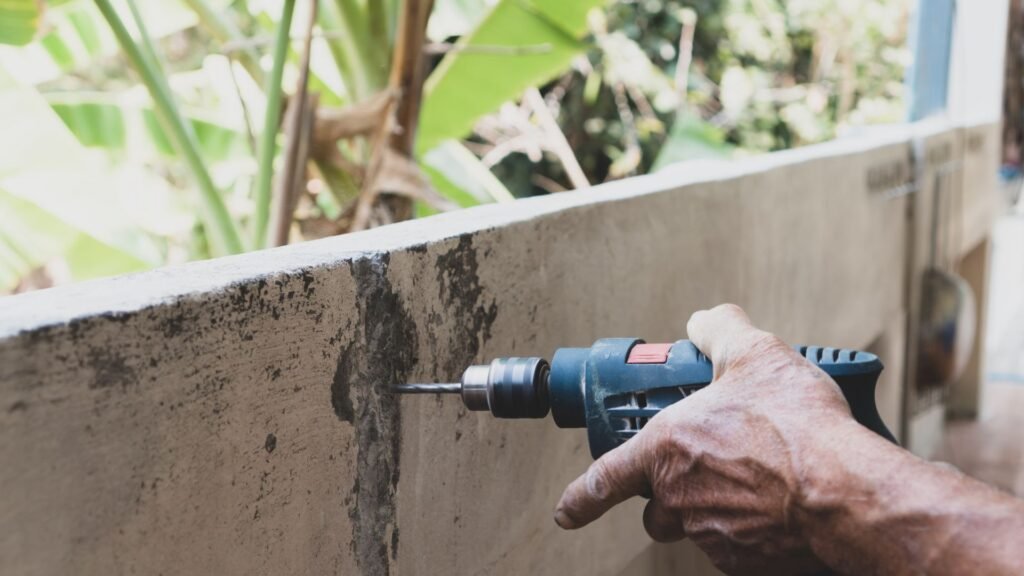
Essential Tools And Safety Gear
Before drilling holes in concrete, you need the right tools and protective equipment. Without them, the job becomes harder, less accurate, and potentially unsafe. Below are the essentials you should have ready.
Hammer Drill Vs. Regular Drill
When it comes to drilling into concrete, a hammer drill is the clear choice. Unlike a regular drill that only rotates, a hammer drill combines rotation with a hammering action that breaks up the dense material as it drills. This added force makes it much easier to cut through tough surfaces like concrete, brick, or stone. A regular drill might handle very shallow or soft masonry, but for consistent, clean holes in concrete, a hammer drill saves time and reduces wear on your bits.
Masonry Drill Bits (Carbide-Tipped)
Concrete is abrasive and will quickly damage standard drill bits. That’s why masonry bits with carbide tips are essential. The carbide cutting edge is tough enough to grind through aggregate and withstand the high friction of drilling. Having multiple sizes on hand helps you start with a small pilot hole before moving up to the final size, which improves accuracy and reduces the chance of cracking the concrete.
Vacuum Or Brush For Dust
Concrete drilling produces a significant amount of fine dust. If it’s left in the hole, it can block anchors from sitting correctly or reduce the strength of fasteners. Keeping a vacuum or stiff brush nearby allows you to clear dust regularly during drilling. Some hammer drills even come with attachments that connect directly to a vacuum, making cleanup easier and keeping the workspace safer.
Safety Gear: Goggles, Gloves, Dust Mask, Ear Protection
Safety should never be an afterthought when working with concrete. Always wear safety goggles to protect your eyes from flying debris. Sturdy gloves provide grip and shield your hands from vibration and sharp fragments. A dust mask or respirator is crucial because concrete dust contains silica, which can irritate your lungs and cause long-term health issues if inhaled. Finally, don’t forget ear protection. Hammer drills are loud, and extended use without earplugs or earmuffs can damage your hearing.
Why Safety Matters: Concrete Dust Is Harmful
Concrete dust may seem harmless at first, but it’s one of the biggest risks when drilling. The fine particles can travel deep into your lungs and lead to respiratory problems over time. Short-term exposure might cause coughing or throat irritation, but long-term exposure can contribute to serious health conditions. This is why wearing a proper mask and working in a well-ventilated area is just as important as using the right tools.
Taking time to prepare the right tools and gear not only makes drilling more efficient but also ensures your safety throughout the process. With the proper drill, durable bits, dust management, and protective equipment, you’ll be set up for success before you even start making the first hole.
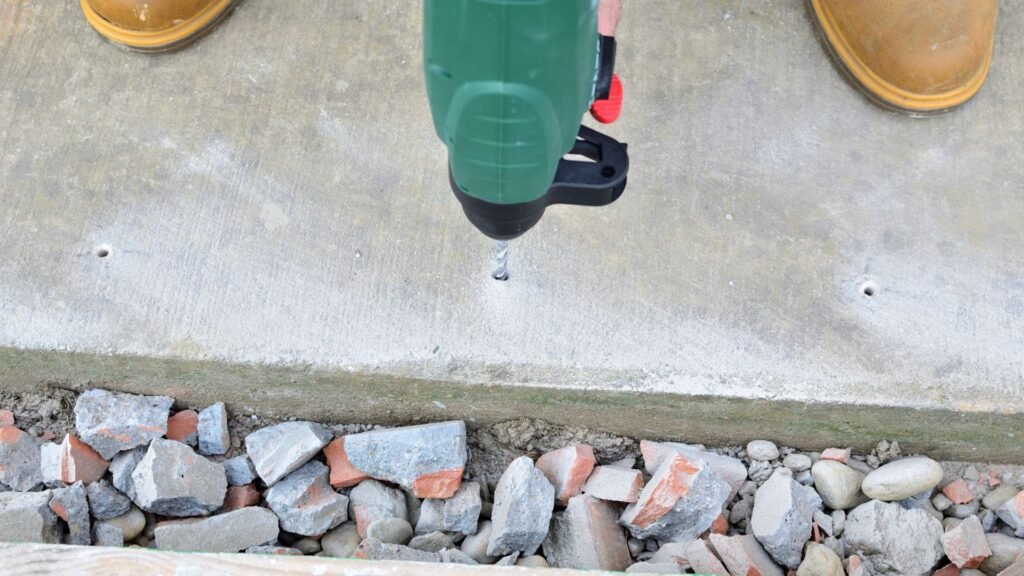
Preparing Before You Drill
Before you begin drilling holes in concrete, preparation is the key to achieving clean results and avoiding costly mistakes. Concrete is a tough material, and jumping straight into drilling without a plan can lead to cracks, broken bits, or even damage to hidden structures inside the wall. Taking a few extra steps before you start will save you both time and frustration.
- Marking the exact spot with a pencil or marker: Precision is important when drilling into concrete. Once you know where your hole needs to be, use a pencil, chalk, or marker to make a visible mark on the surface. This ensures that the drill bit won’t wander and helps you maintain accuracy throughout the process. A clear mark also gives you a visual guide, especially when drilling multiple holes in a straight line.
- Checking for rebar, wiring, or pipes using a stud finder or scanner: Concrete walls often contain steel reinforcement bars, electrical wiring, or plumbing pipes hidden beneath the surface. Accidentally hitting one of these can not only damage your tools but also create safety hazards. Use a reliable stud finder or wall scanner to check the area before drilling. If you detect rebar or wiring, move your mark slightly to avoid these obstacles. This step is especially important if you’re learning how to drill into concrete wall without cracking or causing long-term structural damage.
- Starting with a smaller pilot hole before the final hole: A pilot hole acts as a guide for your drill and helps prevent the bit from slipping. Begin with a smaller masonry bit to create a shallow hole, then switch to the larger bit needed for your final size. This step makes drilling smoother, reduces pressure on the drill, and minimizes the risk of cracking. A properly drilled pilot hole in concrete also improves accuracy, which is crucial when installing anchors or fasteners that need to bear weight.
Taking these preparatory steps not only makes the job easier but also ensures the safety and longevity of your project. With careful planning, you can drill precise holes in concrete without damaging the wall or your tools.
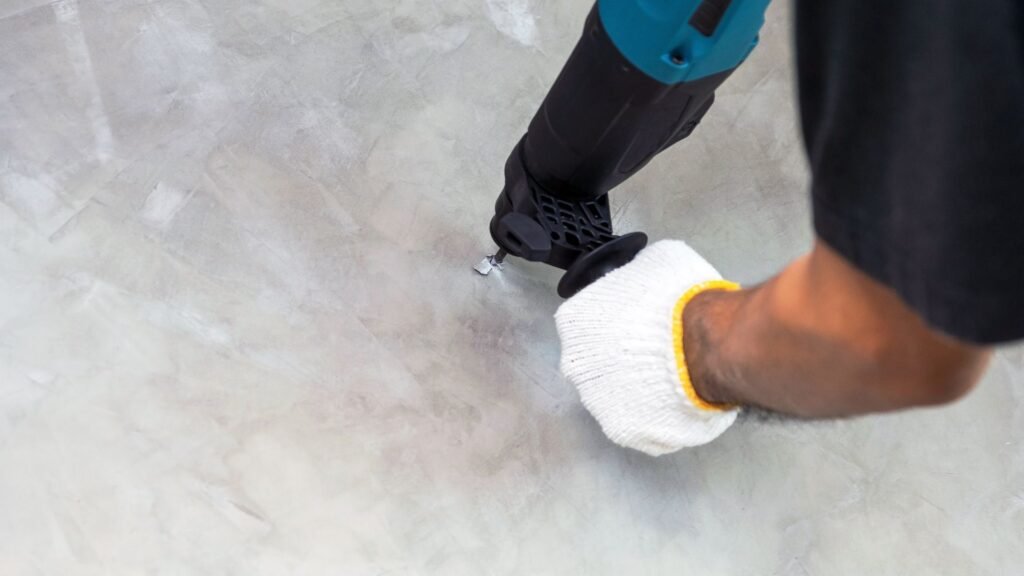
Step-By-Step Guide: Drilling Holes In Concrete
Drilling holes in concrete may seem challenging at first, but when you follow the right process, it becomes a straightforward task. The key is to work methodically, use the proper tools, and let the drill do the work for you. Below is a clear step-by-step guide you can follow to get accurate and clean results every time.
Step 1: Insert The Right Bit Into Your Hammer Drill
Always start by choosing the correct masonry bit. A carbide-tipped bit is best for drilling holes in concrete because it can withstand the hardness of the surface. Secure the bit properly in your hammer drill to prevent slipping and ensure smooth drilling.
Step 2: Position The Drill Perpendicular To The Surface
Hold the drill at a 90-degree angle to the concrete. This keeps the hole straight and avoids unnecessary strain on the bit. A slight tilt can cause uneven holes, making it harder to secure anchors or screws later on.
Step 3: Apply Steady Pressure—Let The Drill Do The Work
Do not force the drill into the concrete. Instead, apply steady and moderate pressure. The hammer drill is designed to break through the dense material, so pushing too hard can damage both the bit and the drill.
Step 4: Pause To Clear Dust
Concrete creates a lot of dust while drilling, which can clog the hole and slow down progress. Every few seconds, pause and pull the bit out to release debris. You can also use a vacuum or compressed air to clear the hole more effectively.
Step 5: Deepen The Hole Gradually
Work in short bursts, gradually deepening the hole to your desired depth. Trying to drill the full depth in one go often leads to overheating or bit wear. Patience here ensures a cleaner and longer-lasting hole.
Step 6: Clean The Hole For Anchors Or Screws
Once the drilling is complete, remove all the dust from the hole. Use a small brush, vacuum, or blast of air to make sure it’s clear. A clean hole allows anchors and screws to grip securely, which is essential for stability.
Troubleshooting Tips
- Bit getting stuck: Reverse the drill slightly to loosen the bit and resume drilling slowly.
- Overheating: Stop drilling and let the bit cool down before continuing. A hot bit wears out faster.
- Shallow holes: Use a depth guide on your drill or mark the bit with tape to track how deep you’re drilling.
Why You Should Not Force The Drill
Forcing the drill can damage the bit, overheat the motor, and create cracks in the concrete. By letting the hammer drill do the work, you not only protect your equipment but also get cleaner, more accurate holes.
Drilling holes in concrete becomes manageable when you follow these simple steps and use the right techniques. With patience and the proper approach, you can create clean, reliable holes ready for anchors, screws, or any other fixtures you need to install.
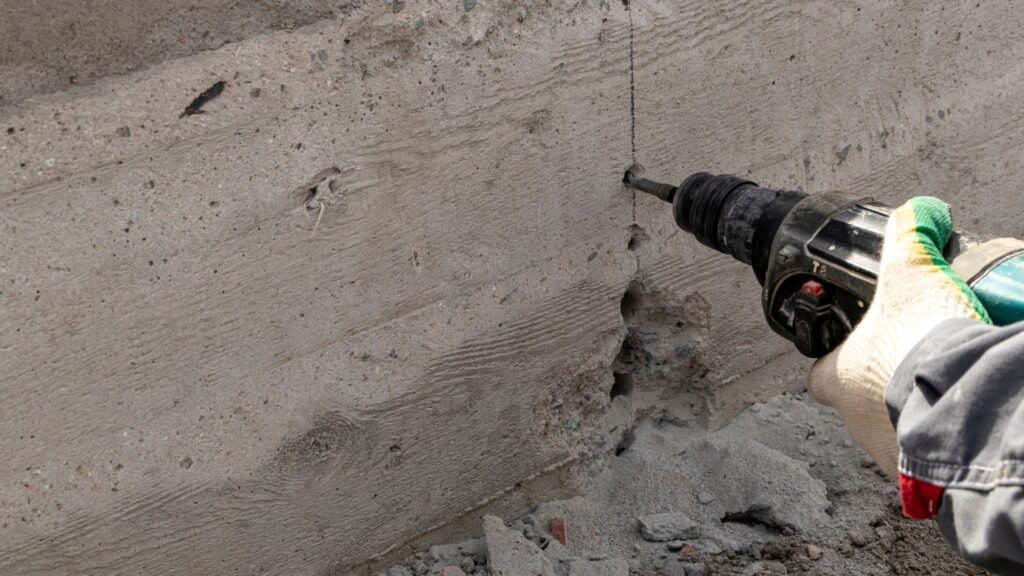
Dealing With Common Challenges
Drilling into concrete can present several unexpected obstacles, even for people who have the right tools and preparation. These challenges are not unusual, and knowing how to address them can save time, protect your equipment, and prevent damage to the concrete surface. Below are some of the most common issues people face when drilling into concrete and practical ways to manage them.
Hitting Rebar: What To Do If Your Drill Hits Metal
Rebar is a steel reinforcement used inside concrete to strengthen the structure. If your drill suddenly stops progressing or produces sparks, you may have hit rebar. For light-duty projects, the best option is to reposition your hole a few inches away to avoid damaging your bit. If moving the hole is not possible, consider using a rebar cutter or a specialized rebar drilling bit designed to penetrate steel safely. For larger jobs, consulting a professional may be necessary, as cutting through rebar incorrectly can weaken the structure.
Bit Overheating: How To Cool It Down
Drill bits can overheat when drilling into concrete due to the hardness of the material and the friction produced during the process. Overheating shortens the life of your bit and makes drilling more difficult. To prevent this, work in short bursts instead of applying constant pressure. Periodically pull the bit out to allow air to cool it, and clear away dust that contributes to heat buildup. Some users also dip the bit in water between drilling intervals, but be cautious when working near electrical outlets or wiring.
Cracks Forming: How To Prevent Or Handle Them
One of the most common concrete drilling problems is cracks forming around the drilled area. Cracks typically occur when holes are drilled too close to the edge, when too much force is applied, or when the wrong drill bit is used. To prevent cracks, always maintain a safe distance from edges, start with a smaller pilot hole, and allow the drill to work at its own pace without forcing it. If a small crack does appear, fill it with a concrete patching compound before continuing with anchors or screws.
Too Much Dust: Using Vacuum Attachments Or Water Spray
Concrete drilling creates a significant amount of dust that can make the process messy and even hazardous if inhaled. The simplest solution is to use a vacuum attachment designed to collect dust directly from the drilling site. This keeps the work area clean and protects your lungs. Another option is to lightly spray the drilling area with water to minimize dust, though this technique should be used carefully to avoid creating mud or interfering with electrical systems.
Dealing with these common challenges is part of the process when drilling into concrete. By understanding how to handle rebar, overheating bits, cracking surfaces, and excess dust, you can ensure cleaner, safer, and more effective results. Taking the time to prepare and use the right techniques not only extends the life of your tools but also gives you confidence in tackling future projects.
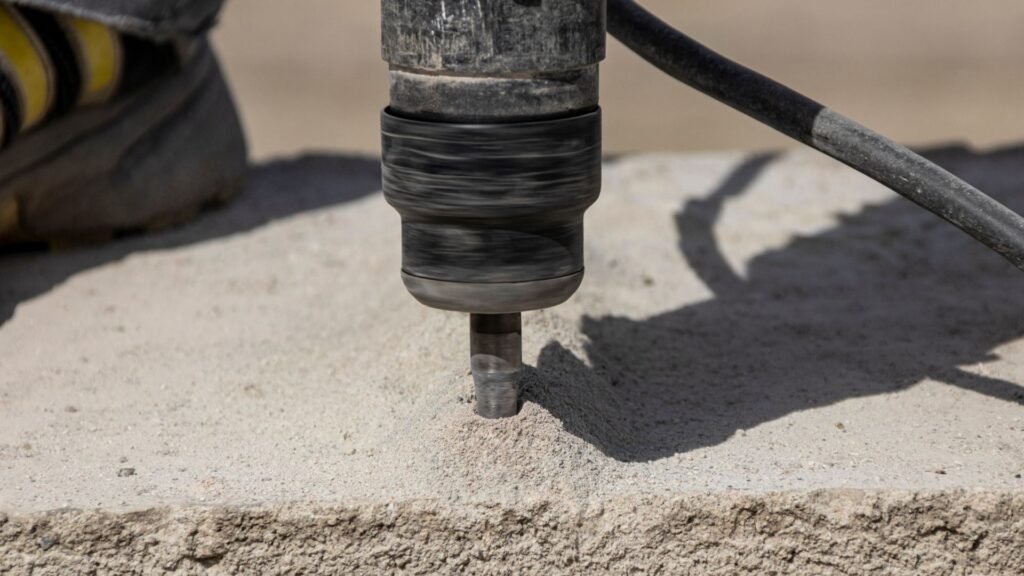
After Drilling: What’s Next?
Drilling into concrete is only half the job. Once the hole is made, the next steps are just as important if you want a strong, lasting result. Skipping proper finishing can lead to loose fasteners, unstable fixtures, or even structural problems. Here’s what to do after you’ve drilled the hole:
Cleaning Out The Hole
Concrete dust and small debris often remain inside the hole after drilling. If left in place, this dust can weaken the grip of anchors or screws. Use a vacuum cleaner with a nozzle attachment to remove the dust, or blow it out with compressed air. A simple wire brush can also help loosen stubborn particles. The goal is a clean surface inside the hole that allows hardware to sit tightly and perform its function.
Inserting Anchors, Screws, Or Fasteners
Once the hole is clean, choose the right hardware for your project. Plastic anchors are useful for lighter loads, while heavy-duty expansion anchors or sleeve anchors are better for shelves, brackets, or wall mounts that carry weight. Place the anchor into the hole and gently tap it in with a hammer until it is flush with the surface. For screws or fasteners, make sure they are rated for use in masonry or concrete to ensure reliability.
Ensuring The Hole Is Stable And Secure
Before applying any load, check the stability of the hole and fastener. Tighten the screw or bolt gradually and make sure it holds firm without wobbling. If you notice any movement, the hole may be too wide or the anchor may not be suitable for the application. In such cases, using a larger anchor or epoxy adhesive can provide additional strength. Always test the setup before mounting heavy items to avoid accidents.
Taking the time to clean, insert the right hardware, and confirm stability ensures that your drilled hole performs exactly as intended. By following these simple steps, you’ll not only save yourself from future repairs but also guarantee that your project is safe, strong, and built to last.
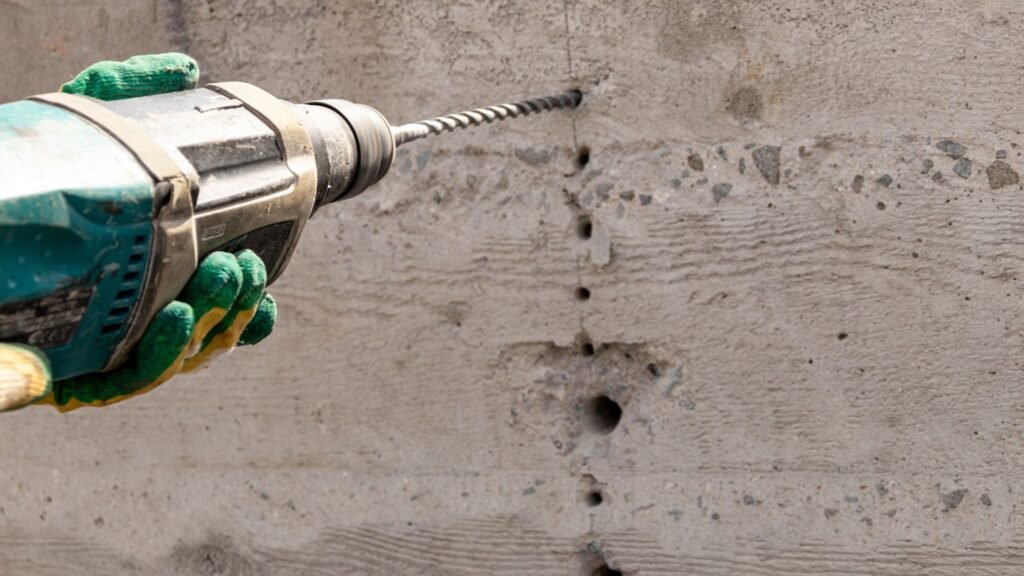
Pro Tips For Best Results
Drilling into concrete can be straightforward once you understand the process, but there are a few extra steps that can make the job smoother and the results more reliable. These practical tips will help you avoid common mistakes, extend the life of your tools, and ensure your project holds up over time. If you are looking for the best way to drill concrete, these proven techniques can save you both time and frustration.
- Use short bursts instead of constant pressure: Instead of pressing the drill continuously, apply short bursts of power. This technique keeps the bit from overheating, prevents unnecessary wear, and helps the drill cut through the concrete more effectively. It also allows dust to escape from the hole, making the process cleaner and more efficient.
- Keep multiple drill bits handy: Concrete is a dense material, and even the best masonry bits can dull or wear down during a project. Having extra bits available ensures you can finish the task without interruption. Switching to a sharp bit at the right time also creates cleaner holes and reduces the risk of damaging your drill.
- Use the correct anchor size for load-bearing projects: When drilling for heavy-duty installations such as shelves, brackets, or wall mounts, using the right size anchor is critical. An anchor that is too small may fail under pressure, while one that is too large can crack the surrounding concrete. Always match the anchor size to the weight and type of load for a safe and secure hold.
- When to call a professional: While many DIY concrete drilling tips can help you manage basic projects, there are times when expert help is necessary. If your project involves structural concrete, reinforced rebar, or large holes for plumbing and wiring, hiring a professional is often the safest option. This ensures the work meets safety standards and prevents costly mistakes.
Taking a little extra time to follow these pro tips can make a big difference in the outcome of your project. By drilling smart and working with the right tools, you can achieve clean, precise results that last.
Ready to take on your next DIY project with confidence? Visit our homepage for more practical guides, expert tips, and tools to help you get the job done right.
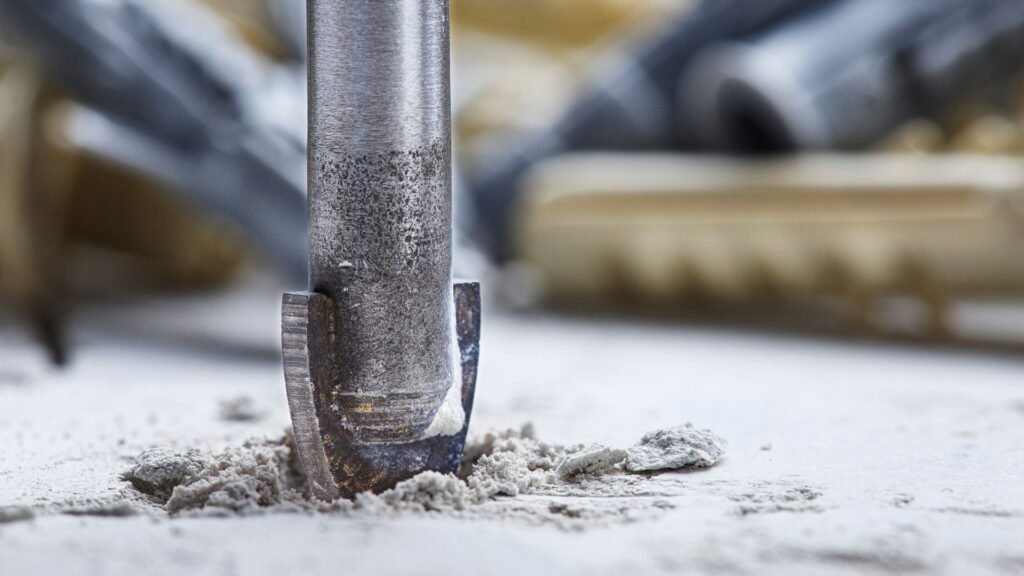
FAQs: About Drilling Holes In Concrete
Can I drill into concrete with a regular drill?
A regular drill can handle very shallow holes in softer masonry, but it’s not ideal for concrete. For best results, use a hammer drill with a masonry bit, as it delivers the power and impact needed to penetrate dense surfaces.
What drill bit should I use for concrete?
Use carbide-tipped masonry bits, which are designed to handle the hardness and abrasiveness of concrete. These bits are stronger and last longer than standard drill bits.
Do I need a hammer drill to drill holes in concrete?
Yes, a hammer drill is strongly recommended. Its hammering action helps break up the concrete while the bit rotates, making the drilling process faster and less stressful on your tools.
How do I stop drill bits from breaking in concrete?
Use the correct type of masonry bit, apply steady but not excessive pressure, and periodically pull the bit out to clear dust. Overheating and forcing the drill are the main causes of broken bits.
How deep should I drill into concrete?
Drill to the depth required for your anchor or screw, usually at least 1/4 inch deeper than the anchor length. Many hammer drills come with depth guides to help ensure accuracy.
What should I do if my drill hits rebar in concrete?
Stop drilling immediately. Rebar is reinforced steel inside the concrete, and you’ll need a rebar cutter or specialized bit if you must go through it. Otherwise, reposition your hole to avoid damaging tools or weakening the structure.
How can I reduce dust when drilling into concrete?
Attach a vacuum to the drill, use a dust shroud, or periodically pull the bit out to clear dust. In some cases, lightly misting the surface with water can also reduce dust, but be cautious with water near electrical areas.
Why does my concrete crack when drilling?
Cracks often occur if you use the wrong bit, apply too much pressure, or drill too close to the edge of the concrete. To avoid cracks, start with a pilot hole and keep the drill steady and aligned.
Can I drill into concrete without cracking it?
Yes, if you use the right tools, drill bits, and techniques. Mark your spot, use a pilot hole, and maintain consistent pressure. Avoid drilling near edges, as this is where cracks are most likely to form.
How do I secure screws or anchors after drilling holes in concrete?
First, clean out the dust from the hole using a vacuum or brush. Then insert the anchor or fastener, making sure it fits snugly. For heavy loads, choose anchors rated for concrete to ensure stability and safety.
Conclusion
Drilling holes in concrete may seem challenging at first, but with the right tools, proper preparation, and a clear step-by-step approach, it becomes a task that most DIY enthusiasts can handle with confidence. Using a hammer drill paired with quality masonry bits, taking time to mark the spot accurately, and maintaining steady pressure while clearing dust as you go will ensure clean and precise results. The key is not to rush—start with smaller projects, practice safe techniques, and build your skills gradually. Don’t be intimidated by the toughness of concrete; patience and preparation make all the difference. For anyone ready to begin, investing in reliable tools and checking your local hardware store for the right gear will set you up for success. With a little practice, you’ll find that drilling into concrete is manageable, safe, and a valuable skill for any home project.

